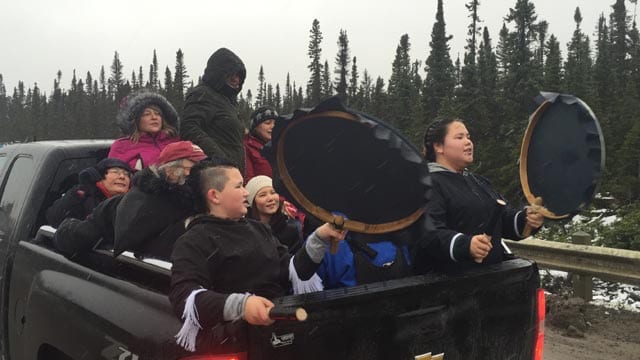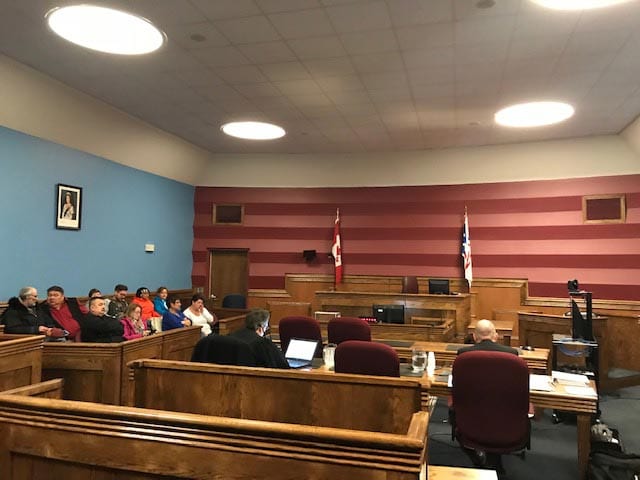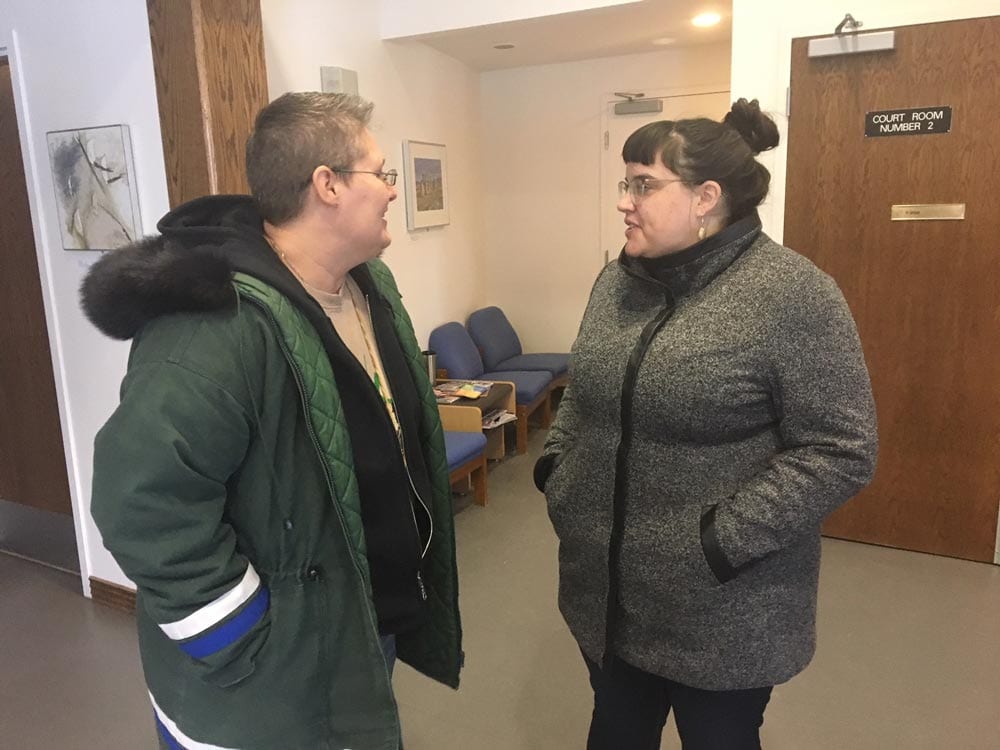
Editor’s Note: As a journalist with the online publication theIndependent.ca, Justin Brake followed the land protectors onto the Muskrat Falls site and workers accomodations complex and covered the duration of the occupation. He is facing criminal and civil charges from the event.
Two years ago Linda Saunders-McLean and about 50 others made a life-changing decision.
On Oct. 22, 2016 the 51-year-old mother and grandmother, a social worker and until recently the head of chapel service at the Moravian Church in Happy Valley-Goose Bay, stormed the Muskrat Falls work site to protect her family and community.
“I feel like they’re going to wipe out who we are, our way of life,” she told APTN News.
Innu and Inuit elders, scientists, Indigenous leaders and others believed that within days of flooding, which was scheduled to begin any day at the time, would contaminate the food web that Indigenous people in the region depend on for their physical, mental and spiritual well-being.
After a land protector cut the lock on an entrance gate along the Trans Labrador Highway, where upward of 200 people were gathered for a protest against the project, Saunders-McLean and dozens of others headed toward the site on foot and in a small convoy of pickup trucks.
They made it halfway to the dam before deciding to occupy the accommodations complex.
Meanwhile, at least 100 others continued a blockade of the site along the highway.
Nalcor Energy, the crown corporation building the $12.7 billion dam, halted most work on the project and sent hundreds of workers home.
The story made national headlines.
(Land protectors occupy the Nalcor offices at Muskrat Falls. Photo: theindependent.ca)
In Newfoundland and Labrador, people watched and waited as the group—most of them Indigenous—changed the narrative of a story that had been, to that point, largely about money, energy, the economy and politics.
In the five years prior Indigenous groups and grassroots people exhausted all means of protecting their health and ways of life.
They tried various avenues to express their concerns—some even tried litigation—over the project.
But when the provincial and federal governments, and the courts, failed to guarantee their safety and rights, they used their bodies in an attempt to prevent flooding.
This week 17 of those land protectors will appear in provincial Supreme Court in Happy Valley-Goose Bay, continuing their fight to defend themselves against what many maintain is still a threat to their health, safety and way of life.
Fear of poisoning, flooding
When she occupied the Muskrat Falls worker’s accommodations complex about 30 kilometres upriver of her home in Happy Valley, McLean, an Inuk and Nunatsiavut beneficiary, was also concerned about the possibility of a catastrophic dam breach, which would put her and her family at risk.
“I live in the flood zone, I have family that I’m concerned about, as well as neighbours,” she says, explaining she is raising her 19-month-old grandson.
“My fear is that one day he may not have a home or may not get the opportunity to live off the land like we’ve been doing for generations.”
Last March during the Missing and Murdered Indigenous Women National Inquiry hearings in Goose Bay, Kim Campbell-McLean, an Inuk woman from North West River, told the Inquiry that resource development projects like Muskrat Falls are negatively impacting Inuit women in the region.
“A lot of women cannot go to the store and buy their groceries to feed their children because it’s just too expensive. So we rely on the country food for subsistence.”
Campbell-McLean, who is among the land protectors in court this week, said any impediment to women accessing traditional foods makes them more vulnerable if they are in violent relationships.
“If a woman wants to leave or decides to leave the household due to violence, if she doesn’t have an income she may decide not to leave,” she explained.
“She may decide to stay, for the children.”
Around 40 individuals, most of them Indigenous, faced civil contempt and criminal charges related to the occupation and other acts of resistance to the project dating back to 2016 and 2017.
Some have represented themselves in court, and some have accepted conditional discharges or suspended sentences, opting to sign undertakings promising they will stay away from the Muskrat Falls site.
The 17 appearing in court this week to defend themselves against Nalcor, which was granted a Supreme Court injunction on Oct. 16, 2016 amid an ongoing blockade of the site.
The following day RCMP officers arrested several land protectors, a move that prompted more to join the resistance.
Days later, Innu, Inuit and non-Indigenous Labradorians reinstated the blockade.
During the occupation Nalcor was granted a second court injunction.
On Monday Nalcor’s lawyers began presenting evidence against the land protectors in an effort to prove each of them is in contempt of court for violating the injunction.
Mark Gruchy, a St. John’s-based lawyer representing the land protectors, says his “objective is to get people to the other end with as minimal damage as possible, while attempting to utilize this process to maximize their voices in the process, which they haven’t had much of.”
Gruchy says he took an interest in the land protectors’ cases because he’s “tired of seeing the collision of Indigenous people–but all people really who have a concern about the well-being of our planet and country and what’s going on with our economy–running into these injunctions and situations so hard.
“This is a long and old story,” he told APTN.
“We have a situation where there is a large number of Indigenous people and their allies very peacefully standing up to this in a way that I think was handled quite well,” he continued, referring to the non-violent nature of the occupation and the other efforts by land protectors to defend themselves and their communities.
On Monday Nalcor attorneys presented video evidence of land protectors involved in the occupation.
Nalcor will continue with evidence Tuesday, and lawyers will cross-examine witnesses.
Hearings are expected to run all week.
Saunders-McLean says the story of land protectors’ actions to defend their land, food and ways of life is bigger than the question of whether people violated a court injunction.
She says it’s part of a larger historical fight to preserve Indigenous cultures, values, traditions and rights.
“Assimilation and colonization continues,” she says.
“We are expected to change and alter our lifestyles to fit a culture or a group of people that really don’t understand what we’re all about.”
Land protectors raise voices amid disagreement between Innu, Inuit leadership and silence from province
Following the occupation provincial and Indigenous leaders struck an agreement to form an Independent Expert Advisory Committee (IEAC) to study and make recommendations on the methylmercury issue.
Recommendations were submitted to the province last April, which included a mercury mitigation plan involving clearing vegetation and soil and capping wetlands in the dam’s reservoir area ahead of the final stages of flooding.
But the Liberal government has not yet announced a decision.
In August Nunatsiavut President Johannes Lampe took aim at Newfoundland and Labrador Premier Dwight Ball for his government’s silence on the mercury issue as the project nears completion.
“The Premier talks about the importance of reconciliation with the province’s Indigenous peoples, yet he continues to show very little respect to our concerns – despite making commitments to the contrary,” Lampe said in a press release.
“His government’s refusal to respond to the IEAC’s recommendations is a step back for reconciliation.”
Leaders from the Innu Nation, whose traditional lands include Muskrat Falls and who signed an agreement in 2011 allowing the project to proceed, have opposed the IEAC’s recommendation.
The land protectors’ occupation of the Muskrat Falls site prompted the October 2016 meeting between Newfoundland and Labrador Ball and the Indigenous leaders, who convened an 11-hour marathon meeting in St. John’s as the occupation continued.
At the time land protectors considered the meeting and subsequent agreement a victory.
But two years later their futures hang in the balance of power and politics between Indigenous leaders with different ideas of how to proceed and a provincial government that ultimately must decide whether the additional costs—estimated between $400 million and $740 million—is worth minimizing the impacts on Indigenous communities in the region.
Saunders-McLean says she hopes land protectors’ messages ring loud and clear this week in the courtroom and beyond.
“They have to hear us when we say that my home is important to me, my traditional lifestyle is important to me, and that’s who I am. If we allow them to continue to destroy everything in Labrador, they’re going to kill us off.
“To me it’s cultural genocide, modern day genocide,” she continues.
“Why are we less important than this injunction and this project?”
APTN will have ongoing coverage from Labrador this week.















Justin, THANK YOU so much for covering the Labrador Land Protectors. As you’ve seen in court today there’s no other media who has shown interest in what’s happening with us. You are a true reporter who’s not afraid to share the truth!
Justin, THANK YOU so much for covering the Labrador Land Protectors. As you’ve seen in court today there’s no other media who has shown interest in what’s happening with us. You are a true reporter who’s not afraid to share the truth!